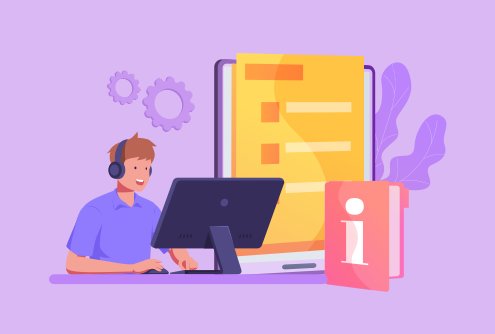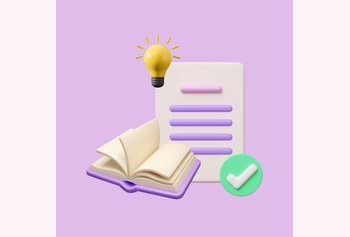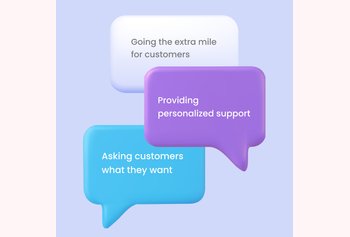You might live and breathe great customer experiences. But if your customer service reps do not share the same enthusiasm or lack the skills to provide great support, your vision of great customer service will remain a vision.
Hiring the right service agents for your team and training them to deliver top-notch service is important. It helps you bring your customer service vision to reality.
As a new business, you might wonder, where do I even begin with hiring the right customer service employees? What does good customer service training look like?
We compiled this detailed customer service hiring and training handbook to help businesses like yours take the first steps towards delivering great customer experiences.
Read on.
Table of Contents
- Why effective customer service hiring and training matters
- Five tips for hiring good customer service employees
- Four tips for effective customer service training
- Great customer service hiring and training lays the foundation for great customer service
Why effective customer service hiring and training matters
The high rates of turnover in the customer service industry, coupled with the high costs of training new employees make it imperative for businesses to hire the right people for customer service roles. On the other hand, effective training empowers reps to deliver great customer experiences and increase customer satisfaction levels.
That’s why building a great customer service team requires a combination of effective hiring and training practices.
According to the Quality Assurance and Training Connection (QATC),call centers in the US have a turnover of 30-45% on average. What’s more, it takes more than $12,000 to replace a contact center agent. This includes the cost of screening, recruiting, interviewing, and training. Hiring the right candidates early on using Recruiting CRM Software helps you avoid additional hiring and onboarding costs when bad-fit employees leave.
Moreover, the quality of customer service you provide can become a make or break factor in customer retention. A whopping 92% of customers would abandon a brand after two negative experiences. So it’s important that you cultivate a culture of customer service excellence in your team.
A good training program empowers reps to put their best foot forward and offer great quality service. Training also helps them feel confident and motivated, and happy agents are more likely to stay with your company.
Five tips for hiring good customer service employees
Hiring is one of the most important activities you’ll perform as a customer service leader. Good customer service hiring practices can help you build a strong team that delivers top-notch service.
Here are five tips to craft the perfect customer service job description and hire the right customer service representatives for your business:
1. Make a list of customer service skills that matter to your business
Some businesses may care about their customer service reps having a sense of humor, while others may want empathy as a must-have skill. To craft a good customer service job description, you’ll want to first round up lists of must-have skills for your business.
Make a list of customer service essentials such as communication skills, conflict management skills, emotional intelligence, persuasion skills, use of positive language, and tech-savviness.
Then, add skills that matter to your brand such as a sense of humor, the ability to chat with customers about their day, or the ability to deliver bad news in an empathetic way. For a technical product is technical, customer service reps need to have specific technical skills to troubleshoot problems. Make a list of those additional skills too.
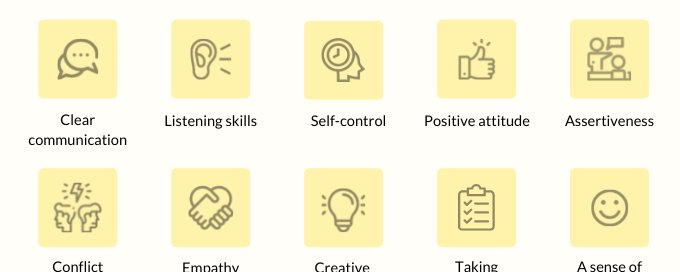
2. Write a clear customer service job description
Once you decide the skills you need for your customer service job positions, write a clear job description that explains the requirements and responsibilities of the job.
A good job description will help you attract relevant applicants who are motivated to work for your company. It should include basic as well as any additional requirements of the job, such as specific working hours, skills, and work experience.
Here’s a basic template you can follow to write a clear and thorough job description:
- Overview
- Responsibilities of the role
- Basic qualifications and requirements for the job
- The benefits you offer
- An ‘About Us’ Section showing what your company does.
Take a look at this example of a customer support specialist position from Hiver.
Note how they clearly mention this is a full-time role with different shifts, in the ‘Requirements’ section. They also specify the technical skills and work experience required for the role.
3. Post your job in the right places
Posting a job on your own website will elicit some responses, but not many. Ensure your job is exposed to as many relevant candidates as possible. Post your job on other job boards and social media channels too.
Many businesses have found success by utilizing methods similar to those used by First Class workforce solutions, focusing on both wide-reaching exposure and industry-specific targeting. This kind of strategy could help you find the perfect candidate, providing a balance between quantity and quality of responses.
Here’s a list of the top job boards which may help you attract qualified candidates:
And here are a few job boards solely focused on customer service employee hiring. Take a look at these too:
The wider the reach of your job post, the greater the chances of attracting quality candidates.
4. Ask the right questions in interviews
As your ad goes live, you’ll start attracting a range of candidates for the position. The interview process will help you narrow down your list to the best candidates for your team. The right interview questions can make your interview process more effective.
Here’s a list of customer service interview questions to include in your interview process:
- How do you handle extremely angry customers? – This is an important question to evaluate potential candidates, as customers may get angry all the time on a customer support call. The candidate’s answer should reveal how they would handle the situation in a calm, collected way.
- What does good customer service mean to you? – This question helps you find out if a candidate’s idea of customer service is the same as yours.
- Where do you see yourself in five years? – This helps you identify if an agent is interested in customer service as a career or not. The more interested candidates are in pursuing customer service as a career, the better they’ll try to get at their job.
- How familiar are you with our brand? – This helps you gauge if a candidate has done their research, and if they’re aware of your brand goals and mission.
- What’s your experience with customer service technology? – Candidates who have sufficient experience with online helpdesk software and live chat support software will be easier to train and onboard.
Recommended Reading

5. Test agents’ customer service skills
The initial interview process will help you narrow down your list of candidates to a select few. But will those candidates actually perform a good job at work? To find this, set up a mock customer service skills test before extending a job offer.
A common way to test a candidate’s customer service skillset is through a role-playing round where you give them different scenarios they might encounter with customers and observe their response.
You can send sample scenarios via email and ask candidates to send their responses. If you offer phone support, do a sample phone assessment where someone from your company becomes the customer and talks about an issue.
For instance, you can give a scenario of a new customer having problems with your checkout process or facing bugs in your product.
Be sure to test candidates’ abilities for a wide range of scenarios and areas. The goal is not to see if candidates can give the “right” answer. You should check if they’re able to think on their feet, search your knowledge base and website for responses, and be able to offer friendly, personable support.
Recommended Reading

Four tips for effective customer service training
Finding the right candidates for your customer service team is not enough. You’ll need to provide them with the right training and knowledge, so they can better serve your customers.
Before you begin training your new hires, it’s important that you clearly structure your customer service training program. Identify the different customer service skills and competencies that you want to train your agents for. Spell out the training modes. You can include a variety of training methods like role-plays, webinars, training games, etc. And lastly, make sure you list down your desired training outcome and a way to measure it.
Here are four tips that will help develop a culture of customer service excellence and boost your customer loyalty:
1. Set up an effective agent onboarding process
Done well, an onboarding process helps you empower your new recruits to do their job well and increase retention.
An effective agent onboarding process covers everything from discussing the core values of a company to detailed sessions on your product and customer support software.
Here are five tips to make your agent onboarding process more effective:
- Start with offering product knowledge – Your customer service reps need to know your products and services in and out to be able to offer quick, accurate responses to customers. In the beginning, allow them to spend as much time as possible understanding the products you offer, their features, benefits and pricing.
- Teach them to use your support tool – You likely use customer support software to help your team route tickets and send faster replies to customers. After your new hires are familiar with your product, let them spend some time using your customer support software. Through the onboarding process, they should learn how to route customer service requests, save replies as templates, tag customer requests, and collaborate with team members for faster problem solving.
- Help new hires build a rapport with managers – Building a good rapport with managers early on can help new joinees resolve any issues they’re facing in their work at the earliest. Involve service managers throughout the new agent onboarding process, so agents can get familiar with their managers. Ask managers to meet with them on a routine basis to identify any problems they may face during the onboarding process.
- Teach them how to use your knowledge base – Companies create an internal knowledge base (KB) for their team members to quickly access important information such as benefits and features of products, tech help, organizational structure and so on. During the onboarding process, be sure to teach your reps any shortcuts and workflows that may help agents quickly search for important information in your knowledge base. This will help them quickly resolve customer queries.
- Allow your reps to handle fake support requests – Just as a mock test during the interview process helps you gauge an agent’s skills and presence of mind, fake support tickets help agents learn on the job. These fake support requests might contain the top customer concerns and issues your reps generally solve. You can set up these fake support requests in your customer service software or an LMS software of your choice.
- Have a system to verify their skills after onboarding – Good onboarding prepares your new hire to become a valuable member of your team and a valued resource for customers. But it’s important that once the onboarding process is over, you verify your new agents’ skills and learnings before they can start handling customers. Do note that it’s equally essential for you to have an action plan for those who fail to meet your minimum performance threshold requirements.
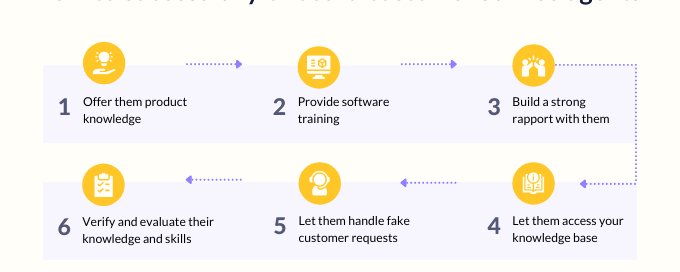
2. Encourage your customer service team to learn on an ongoing basis
According to one LinkedIn survey, 94% of professionals said they would stay with a company that invested in their career. That’s why it’s important to encourage agents to develop their skills and grow their careers on an ongoing basis.
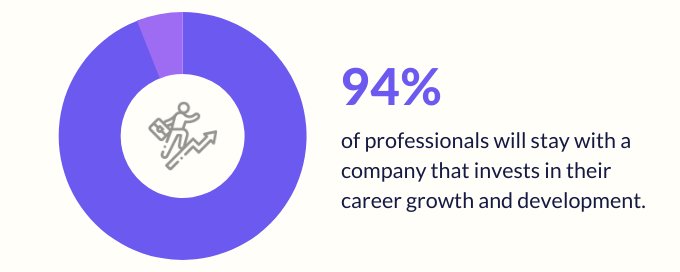
Here are two ways to foster an environment of continuous learning in your team:
- Encourage peer-to-peer learning – Peer learning is a way of helping employees interact, teach and be taught by one another. To learn from their peers, support reps can provide feedback and tips to other teammates by reviewing their customer service interactions. You can also allow reps to peek into or listen to conversations of high-performing reps to help them get a feel for what great customer service looks and sounds like. You can promote peer learning by establishing a ‘straight-talking culture’ in your organization, where employees are not afraid to give or accept criticism and work to improve their skills.
- Set up a learning management system – A learning management system is a software where you can set up courses and other resources to help your agents learn on an ongoing basis. You can create your own courses as well as use ready courses by other organisations to teach your team. Some popular LMS platforms include TalentLMS, TovutiLMS, VioletLMS and Saba Cloud.
- Conduct periodic training sessions – Whether it be quarterly, half-yearly, or yearly – you need to continuously evaluate your customer service team’s performance and conduct training for skills they lack. Some effective ways to do this include conducting team-building sessions, playing customer service training games, and performing role-plays.
3. Conduct quality assurance reviews to identify coaching opportunities
Customer service quality assurance is a process that involves reviewing customer service interactions to gauge agents’ performance and provide feedback for improvement.
Quality assurance managers listen to or read customer interactions and identify areas where agents may need more training and help. Keeping a track of soft metrics like empathy, tone of voice, body language, and hard metrics like the number of customer complaints, CSAT scores, etc. can help shape your training programs.
Customer service quality assurance is a great way to provide quality customer support at a consistent clip and pinpoint performance outliers. In fact, as per Hiver’s latest Customer Service Benchmark Report, 51% of customer service teams analyze support conversations to infer customer feedback.
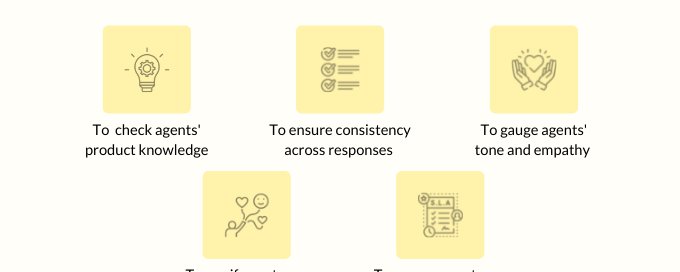
4. Reward instances of great customer service
Great customer service training doesn’t end with teaching key skills. It also involves rewarding agents for good work, so they’re motivated to do better.
Review if your customer support team members are able to cater to customer needs effectively. Recognize and reward these instances of great customer service to help them feel appreciated. A peer recognition system, where employees call out great work from their peers also works well in keeping employees motivated.
For example, Zappos has a peer-to-peer employee rewards program, where Zapponians can acknowledge peers who demonstrate company values and culture. This helps keep team spirit high. To enhance your customer service team’s effectiveness, consider leveraging custom e-learning software development solutions. These platforms can be tailored to your specific needs and provide comprehensive training modules that align with your customer service goals.
Great customer service hiring and training lays the foundation for great customer service
92% of consumers are more likely to make another purchase after a positive customer service experience. But to exceed customer expectations and deliver positive customer experiences consistently, you need a great team of customer service employees.
Spend some time crafting a good job description to attract the right candidates to your customer service jobs. Ask the right interview questions to identify good-fit candidates.
Finding the right candidates is only the beginning though. You’ll also need to provide sufficient training and onboarding for new reps to get up-to-speed on your products, brand, and tools.
Even after agents are successfully onboarded, you should continue to train them on a routine basis, and reverify their skills, annually.
Invest time and effort in hiring and training customer service reps well. You’ll be able to serve your customers better in the long run.








